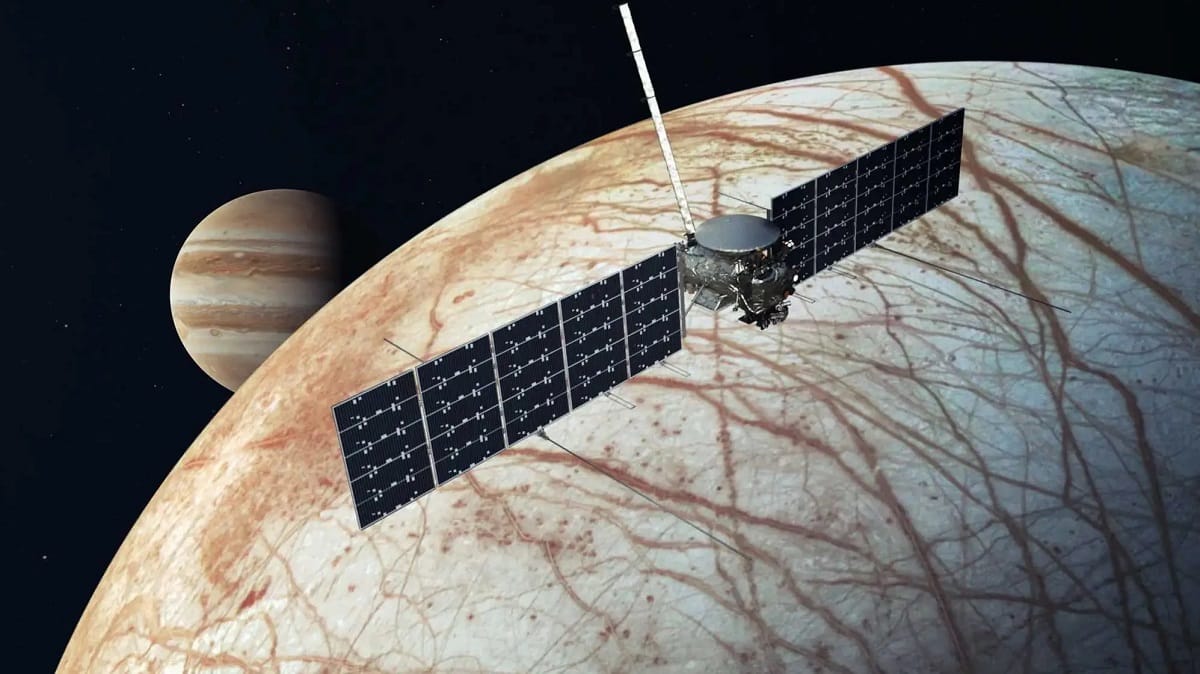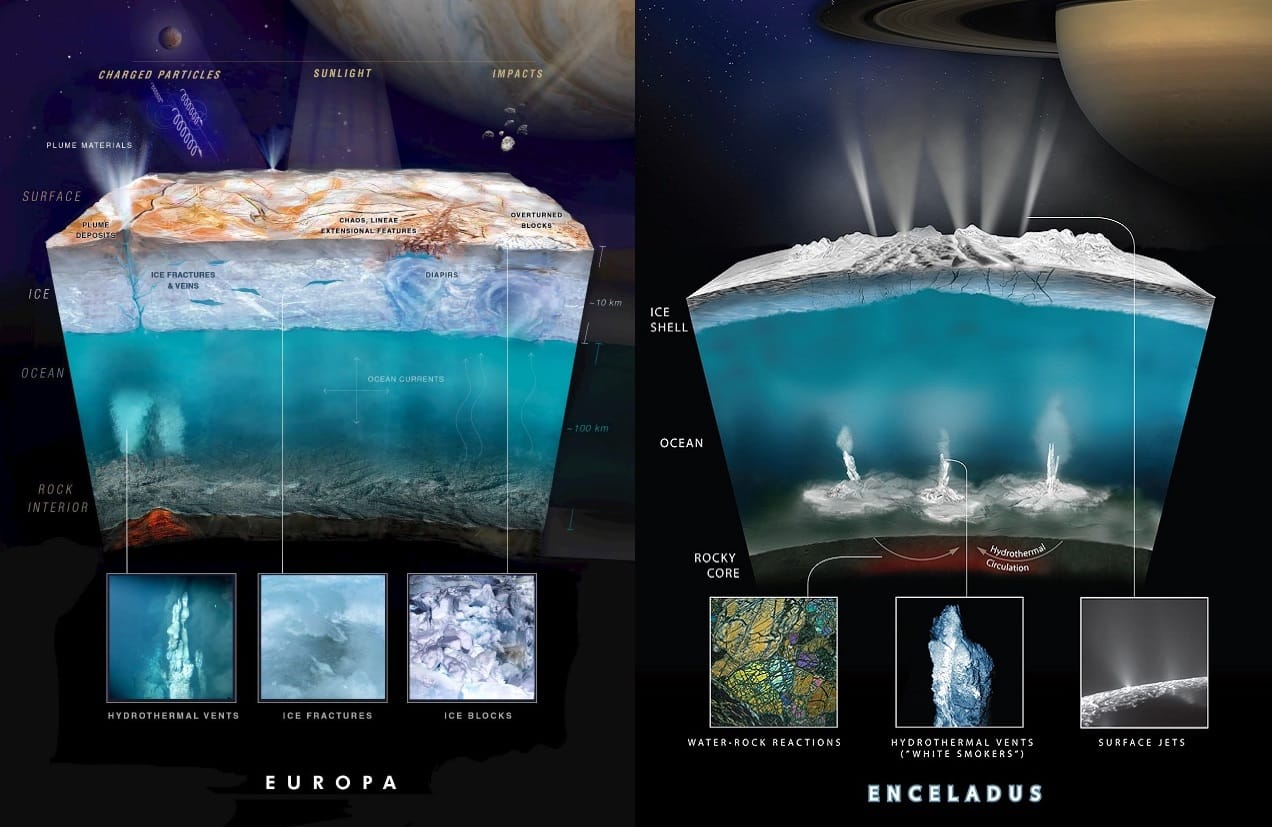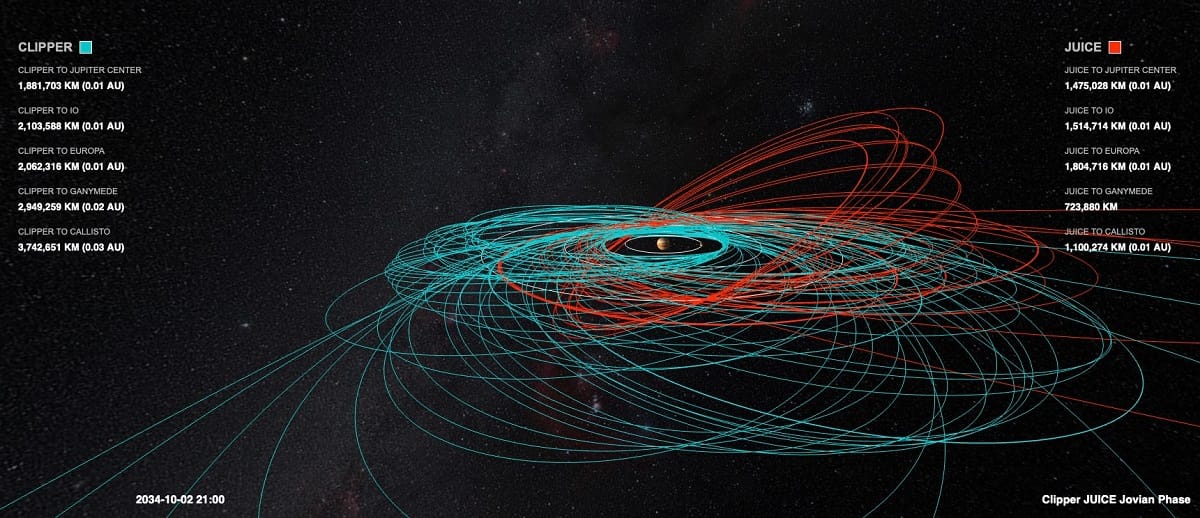
From Earth to Jupiter
Two space missions may tell us if Jupiter's moons harbor extraterrestrial life.
If life were found on Jupiter’s moon Europa, it would be the most significant discovery in the history of space exploration. It would fundamentally change our understanding of biology and prove the potential for life beyond Earth.
The discovery of life on Europa would mean a massive boost to scientific research. It would motivate further missions to study the new life forms. Most of all, it would raise an ethical question: Do we have the right to disturb other worlds?
What Europan life might be like
If life exists on Europa, it wouldn’t require sunlight. Most likely, it would thrive in ocean environments through chemosynthesis, the process of converting chemical energy into organic matter using chemical compounds like hydrogen sulfide or methane as an energy source. It would be fueled by Jupiter’s radiation and hydrothermal vents on Europa’s seafloor.

Europan life would likely be microbial, adapted to a dark, high-radiation environment. Scientists would be eager to study its biology, how it evolved, and its biochemical processes. This would potentially trigger a demand for further space exploration and eventual colonization.
There would be new ethical questions about interacting with extraterrestrial life with possible implications for human existence and religious beliefs.
As exciting as finding life in Europa would be, we should pause and think beforehand how humanity would react.
We have a few years to think about this while we wait for the results from Europa Clipper and JUICE.
Coming soon to a gas giant near you
NASA’s Europa Clipper and ESA’s Jupiter Icy Moons Explorer (JUICE) are flagship missions to Jupiter’s system of icy moons, aimed at assessing their potential for habitability and life. Europa is at the top of this list.
Europa is Jupiter’s fourth largest moon, out of a total of 95. Europa is about 90 percent the size of Earth’s Moon, and is believed to harbor a global saltwater ocean with more liquid water than all of Earth’s oceans combined.
In the video below, Professor Brian Cox explains that all the ingredients that we think are necessary to support life are present on Europa:
“Everything we think we know about the origin of life, all the ingredients that are necessary seem to be present on Europa. So, if we go there and send a cryobot into the oceans of Europa and find nothing at all, then it may be far more likely that we are alone for millions or even billions of light years in every direction.” —Professor Brian Cox
Mission objectives
Europa Clipper carries cameras, spectrometers, radar and particle instruments to map Europa’s surface and subsurface in detail. It will search for organic compounds, salts, and geological activity such as water plumes that could provide chemical energy or biological materials at the surface. It will test if Europa has “the ingredients needed for life” such as organic materials, energy, and habitable ocean conditions.
JUICE’s mission objectives are to characterize Jupiter’s three large ocean-bearing moons, Ganymede, Callisto, and Europa, as planetary objects and potential habitats. Its overarching scientific theme is the potential existence of habitable worlds around gas giants.
JUICE will conduct remote sensing and in situ measurement to determine the structure of the moons’ icy shells and oceans, their surface and atmospheric composition, and their interactions with Jupiter’s environment. JUICE will map surface ices and salts looking for organics, probe surface oceans via radar and magnetometry, and study how each moon’s orbit and Jupiter’s magnetosphere affects habitability.
JUICE seeks to reveal whether Ganymede, Europa or Callisto offer or ever offered conditions including liquid water, chemicals, and energy to make the moons suitable for life.
Mission timelines
Europa Clipper was launched on October 14, 2024 on a SpaceX Falcon Heavy. It will spend six years in flight to reach Jupiter, and will insert into Jupiter orbit in April 2030. After orbit insertion, the spacecraft will perform about 49 close flybys of Europa. The first Europa flyby planned for science will occur in spring 2031, with two main science campaigns in both anti-Jovian and sub-Jovian hemispheres in 2031 to 2033. The current end-of-mission plan is to deorbit Europa Clipper into Ganymede in 2034.
JUICE was launched on April 14, 2023 on an Ariane 5 rocket from Kourou in French Guiana. JUICE is on an eight-year cruise to Jupiter using multiple gravity assists: Earth-Moon in August 2024, Venus in August 2025, Earth in September 2026 and January 2029. JUICE will reach Jupiter in July 2031. Six months later, it will begin its nominal science phase orbiting Jupiter and flying by the moons. The science mission lasts four years, from 2031 to 2035. During that time, JUICE will perform around 35 flybys of Europa, Ganymede, and Callisto. It will eventually enter orbit around Ganymede, starting December 2034.

Scientific instrumentation
Europa Clipper carries nine science instruments plus a radio science experiment. Key instruments include cameras (Europa Imaging System) for high-res color and stereo maps, a thermal IR imager (E-THEMIS) to find warm spots, and ultraviolet and infrared spectrometers (UVS, MISE) to identify surface ices, salts, and organics. It also has an ice-penetrating radar (REASON) to measure ice shell thickness, a magnetometer (ECM) and plasma instrument (PIMS) to infer ocean depth and salinity, a mass spectrometer (MASPEX) to analyze atmospheric and plume gases, and a dust analyzer (SUDA) to sample any particles ejected from the surface. In combination, these will allow Clipper to map Europa’s geology and chemistry in detail.
JUICE carries ten science instruments in addition to the Planetary Radio Interferometer and Doppler Experiment (PRIDE), the most powerful outer-planet payload ever flown. Its remote sensing suite includes a multi-spectral camera (JANUS), an infrared mapping spectrometer (MAJIS), an ultraviolet spectrometer (UVS), and a sub-millimeter wave instrument (SWI). Its geophysical package has an ice-penetrating radar (RIME) and laser altimeter (GALA) to probe surface oceans, and a radio science experiment (3GM) for gravity fields. Its in situ package includes a magnetometer (J-MAG), a particle environment package (PEP), and radio/plasma wave instrument (RPWI) for measuring Jupiter’s magnetosphere and charged particles. Notably, NASA contributed the UVS and hardware for other JUICE instruments.
Both missions carry similar classes of instruments: for example, Clipper’s REASON vs JUICE’s RIME radar. However, JUICE’s suite is tuned for broader surveys of multiple moons, while Clipper’s is focused on intensive reconnaissance of Europa.
Looking for signs of life
Europa Clipper is not a dedicated life-detection mission. It has no plans to look directly for microbes, but it will gather the clues needed to assess Europa’s habitability.
It's expected to reveal Europa’s internal structure and surface chemistry, identifying environments that could support life. It will use its radar and magnetometer to measure the ice shell thickness and ocean depth, and a mass spectrometer to search for organic molecules and salts. Detecting active water plumes or surface deposits of ocean material would be a major discovery. Scientists hope to determine whether Europa’s ocean has the right salinity, energy sources (from tidal heating, for instance), and organic building blocks to be habitable.
JUICE will advance the search for habitable environments by comparing Ganymede, Callisto, and Europa. JUICE will map Ganymede’s ocean (performing the first in situ measurements of a moon’s ocean) and explain why Ganymede uniquely generates its own magnetic field. It will characterize the moons’ surface ices and tenuous atmospheres (Ganymede and Europa have oxygen atmospheres), looking for signs of chemical processes stemming from subsurface oceans. Scientists hope JUICE will enable them to determine how thick and salty Ganymede’s ocean is, whether its ocean (or Europa’s) contains ammonia or other life-friendly organic compounds, and how Jupiter’s radiation environment affects each moon.
JUICE’s findings, together with Clipper’s, will clarify whether any of these ocean worlds have or ever had conditions suitable for life.
Collaboration and complementarity
Europa Clipper and JUICE are designed to operate in a complementary fashion, a scientific dream team. Clipper’s extensive Europa flybys will be matched by JUICE’s survey of Ganymede and additional Europa/Callisto flybys. Thus, the missions cover different niches: Clipper for detailed Europa reconnaissance, JUICE for Ganymede and system-wide context. Their timelines overlap to allow joint observations of the Jupiter system.
NASA and ESA are coordinating wherever possible. For instance, NASA built JUICE’s UV spectrometer and other hardware, and plan to share data. As an ESA factsheet notes, the two spacecraft “will be exploring the Jovian system simultaneously,” and JUICE is said to “directly complement” NASA’s missions.
These combined datasets will let scientists cross-calibrate measurements (for example, two independent measurements of Europa’s ocean) and address big-picture questions about habitability across all the Galilean moons. Together, Clipper and JUICE fulfill the joint science goals of the earlier Europa-Jupiter System Mission concept, broadening our understanding of potential life-friendly environments in Jupiter’s realm.
